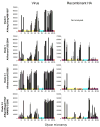Recent avian H5N1 viruses exhibit increased propensity for acquiring human receptor specificity
- PMID: 18672252
- PMCID: PMC2519951
- DOI: 10.1016/j.jmb.2008.04.016
Recent avian H5N1 viruses exhibit increased propensity for acquiring human receptor specificity
Abstract
Adaptation of avian influenza viruses for replication and transmission in the human host is believed to require mutations in the hemagglutinin glycoprotein (HA) which enable binding to human alpha2-6 sialosides and concomitant reduction in affinity for avian alpha2-3 linked sialosides. Here, we show by glycan microarray analyses that the two mutations responsible for such specificity changes in 1957 H2N2 and 1968 H3N2 pandemic viruses, when inserted into recombinant HAs or intact viruses of some recent avian H5N1 isolates (clade 2.2), impart such attributes. This propensity to adapt to human receptors is primarily dependent on arginine at position 193 within the receptor-binding site, as well as loss of a vicinal glycosylation site. Widespread occurrence of these susceptible H5N1 clade 2.2 influenza strains has already occurred in Europe, the Middle East, and Africa. Thus, these avian strains should be considered high-risk, because of their significantly lower threshold for acquiring human receptor specificity and, therefore, warrant increased surveillance and further study.
Figures







References
-
- Webster RG, Govorkova EA. H5N1 influenza--continuing evolution and spread. N Engl J Med. 2006;355:2174–2177. - PubMed
-
- Antonovics J, Hood ME, Baker CH. Molecular virology: was the 1918 flu avian in origin? Nature. 2006;440:E9. - PubMed
-
- Gibbs MJ, Gibbs AJ. Molecular virology: was the 1918 pandemic caused by a bird flu? Nature. 2006;440:E8. - PubMed
Publication types
MeSH terms
Substances
Grants and funding
LinkOut - more resources
Full Text Sources
Other Literature Sources

